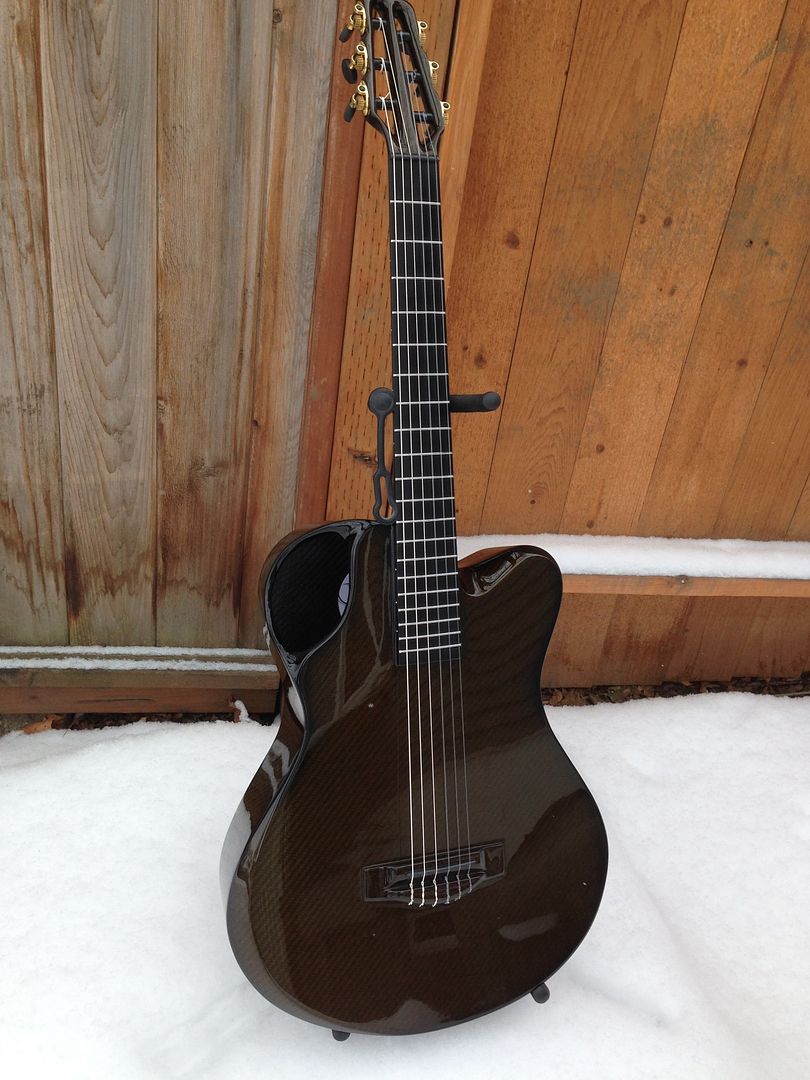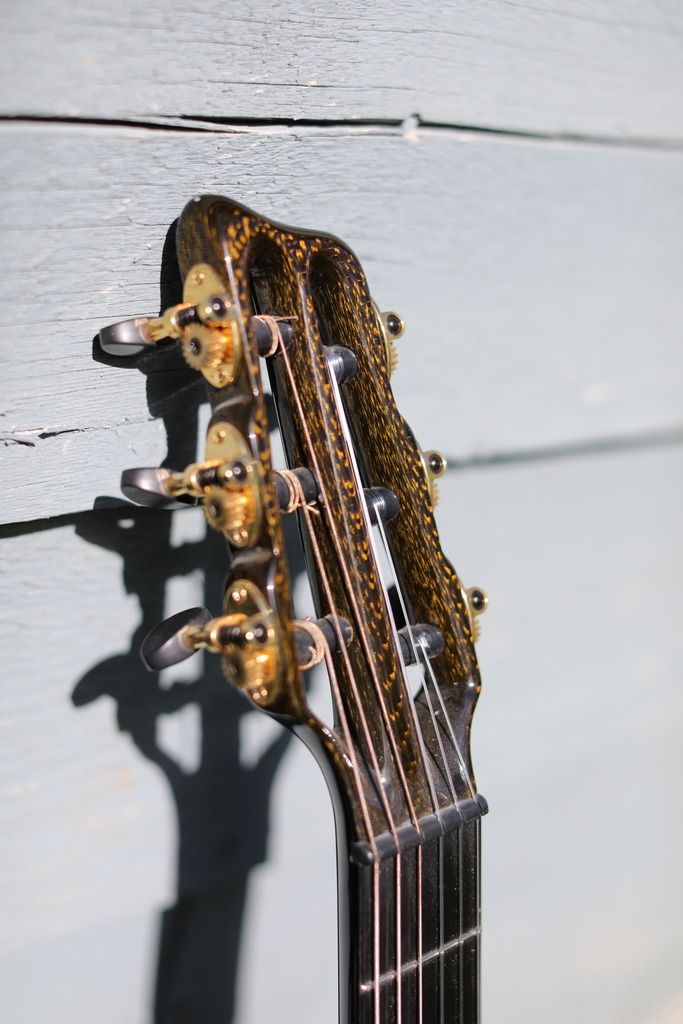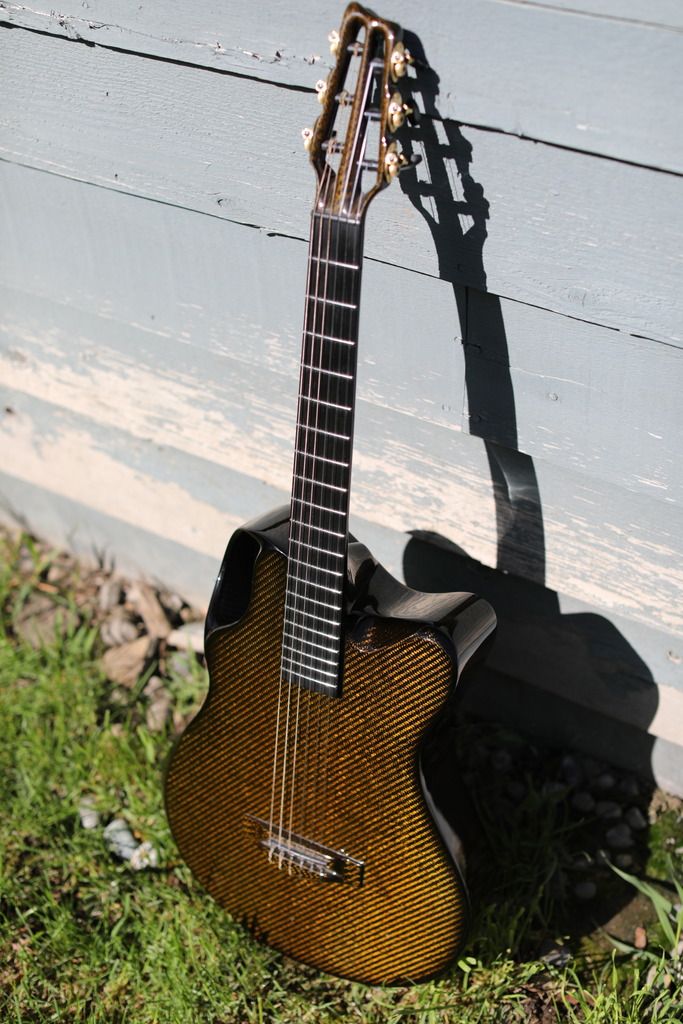
 |
|
#1
|
|||
|
|||
|
With the increase of interest in crossovers, due mostly to Emerald's custom options, I would like to share an observation about nylon in general. This may help people design a more desirable guitar.
Classical guitars are extremely well designed, and any deviation for crossover purposes must have a reason. Clearly, a narrower neck, radiused fretboard, and rounder neck profile make a crossover more comfortable to play for traditional steel string players. This is a good reason, because comfort is king. Bridge position, however, is an issue. All classical guitars (that I know of) place the bridge in the 12 fret position, which is in the center of the lower bout. Classicals are available with scale lengths of 660, 650, 640, and 630mm lengths, and they all place the bridge in the 12 fret position. This is not a random coincidence, there is a reason. Steel string guitars typically have a 645-650mm scale length for 14 fret designs, and a 622-632mm scale for 12 fretters, also for a reason. Here is the issue. Crossovers are modified classicals, not modified steel string guitars, because string tension is the defining parameter in guitar design. Since most classical makers don't deviate from their classical design, hence the designation of "classical", most crossovers come from steel string makers who are accustomed to designing long scale guitars as 14 fretters. This is a mistake. The reason why I bring this up is because, in another thread, I noticed that Ted said Rainsong NP's were tried with a long scale, thinking that the greater tension may help with projection, but it didn't. My guess is that a longer scale would help the NP, but that this benifit is negated when the bridge is shifted from the 12 fret NS position to the 14 fret N2 position. Also, photos of Emerald's X20 Nylon and Evan's X10 Nylon reveal a 14 fret design. The simple truth is that nylon strings need a bridge in the center of the lower bout, and here's why. 100% of the energy in a guitar comes from plucking the string. Three things can happen to this energy. 1) It is transmitted from the string, through the bridge, to the soundboard. 2) It is reflected off the bridge, back to the string. 3) It is absorbed by the string as heat. 1+2+3=100% The 12 fret bridge position is more efficient at transferring energy to the soundboard, accentuating the fundamental tone and lower harmonics. The 14 fret position is more effective at reflecting energy back to the string, creating more sustain, and accentuating upper harmonics. With steel strings, this is great because it gives the designer two distinct options that are both desirable in different situations. This is not true with nylon strings. Nylon is so soft, relative to steel, that much of the original energy is absorbed by the string as heat. Because of this, nylon strings naturally have shorter sustain and fewer high harmonics than steel strings, negating all of the benefits that come from a 14 fret bridge position. Nylon strings have a strong fundamental, low harmonics, and dissipate energy fast. The 12 fret bridge position in the center of the lower bout is the only way to get the most from them. Or, maybe I'm just making this up in my head (but I am classically educated on the topic of energy transfer at boundary conditions). Food for thought, at least. |
|
#2
|
|||
|
|||
|
I am very much interested in the crossover world at the moment; I'm even selling my acoustics because of this (although more difficult in Spain - the Classical Guitar world). I prefer the strings on crossovers, there are many more options for sounds on the trebles (by playing style/ability and by the variety of materials available for strings) and the tension is much less.
I have also noticed the things you mention. Crossovers are quite a new concept and so there will be few people like me that want to be 100% crossover. Most are built to please the people that want "a different sound" to add to their stable. And I feel a lot are built for on-stage use. In other words, I my perception is that very very crossovers are built with acoustic sound as their priority. Other things, like nut widths of 44 to 45mm also show that they are built more to please someone dedicated to steel strings. I'm currently looking at cheaper options (wood), as I can't afford a CF crossover yet. The only model I have seen that gives me confidence that it is built for pure acoustic tone is the Cordoba C9 or C10 crossover, as it is basically a full classical body with a modified neck. No electronics. Cordoba also specialize in classical guitars. I think the crossover world with continue to evolve however and improve (maybe even grow). It seems that the carbon fibre companies are working on this more than the wooden companies, relatively.
__________________
Christian Guitar: Camps Primera Negra A (a flamenco guitar) Strings: Aquila SugarAquila Rubino, Knobloch CX, Aquila Alchemia I play: Acoustic blues & folk Videos: https://www.youtube.com/user/sirwhale28/videos |
|
#3
|
|||
|
|||
|
My x20 nylon is a 12 fret with the bridge moved lower. No electronics.
I'm shocked Alistair hasn't made more. If I move forward with an x7 nylon, it will also be a 12 fret. 
|
|
#4
|
|||
|
|||
|
Tom 2;
Good stuff. Rainsong has done a great job (in my estimation) of producing a crossover 12 fret nylon string guitar, the nylon string Parlor. I don't think they have made a 14 fret version, probably for exactly the reasons you mention. I have liked higher fret reach and moved past 12 fret guitars knowing that there is a price. My feeling now is that a cut-a-way and contemporary build can allow for high fret reach even with a 12 fret guitar--the Rainsong Parlor being an example. Nothing is free however and there is a price to be paid for the cut-a-way. I am facing a similar decision involving trade offs with regard to scale length. I have traditionally gone with 25.something which is, as I understand it, an optimal distance for nylon string tension. But I've been liking the shorter scale of the Parlor and thinking of going with that in an electric nylon string guitar. What do you think about that? SirWhale: I think you right about the CF makers being more exploratory in the development of crossover guitars. New materials and new build methods have really opened up the door for options. Blackbird, CA, Rainsong and Emerald have all been pushing the envelope. CFW: What a beautiful guitar. What tension strings are you using? It appears that most of the crossover guitars are using high tension strings which I think enhance projection but maybe lose some tonal quality. Your thoughts??? Last edited by Guest 928; 05-07-2017 at 09:51 AM. |
|
#5
|
|||
|
|||
|
Evan, my current crossover has a 636mm scale and it is a joy to play, there is a significant difference compared to a 650mm scale.
Have you seen my thread in the general section? You'd be interested, although I'm not sure these strings are of your liking: http://www.acousticguitarforum.com/f...d.php?t=468169
__________________
Christian Guitar: Camps Primera Negra A (a flamenco guitar) Strings: Aquila SugarAquila Rubino, Knobloch CX, Aquila Alchemia I play: Acoustic blues & folk Videos: https://www.youtube.com/user/sirwhale28/videos |
|
#6
|
|||
|
|||
|
Man... that headstock just kills me and I am not even a nylon string player.... a x20 steel woody with that headstock, 12 fret, K&K would be the ultimate!!!
|
|
#7
|
|||
|
|||
|
Any comments I make regarding tone, tension and strings are all going to be based on a guitar nobody has ever heard... Alistair made some recordings apparently, but I've never heard them. This guitar is just different. It doesn't compare to any nylon string I have, or have played. I'd love to hear Alistairs comments regarding the bridge placement, and how he's tuning the tops differently now than when mine was made.
I requested the 12 fret placement, with the bridge moved lower more out of classical guitar standards than anything else. I didn't have expectations with the sound, other than I was aware it would probably make a difference... With the cutaway, a 14 fret seems silly considering the comfort advantage of the shorter reach to the first fret, also considering 'classical heritage'... My hopes, with a carbon nylon string guitar, were to bring out the trebles, as I think carbon can excel in this department. It sure seemed to on the steel string Emeralds. The unexpected benefit of moving the bridge was an unbelievable amount of bass available, while still getting great sustain out of the trebles. I'm currently playing with high tension carbon. DiAddario EJ46ff - they were free to try during a promotion, I like them so far... I was using a hard tension before, I think they were the EJ46 nylon. and I really need to get some better pictures to do this guitar justice... |
|
#8
|
|||
|
|||
|
This should be a much better representation of Alistairs craftsmanship, and that fantastic headstock.
 
|
|
#9
|
|||
|
|||
|
Quote:
A spruce/rosewood C10 crossover might brighten up the sound a bit, but if the overtones aren't there to begin with, it won't help much. I imagine string selection would be more critical with spruce/rosewood than with cedar/mahogany. Crossovers are a new innovation, composite materials are a new innovation, and Emerald's customization is a new innovation, which is why we're discussing this here instead of in the classical forum. |
|
#10
|
|||
|
|||
|
Quote:
Actually, I imagine a 640mm 12 fret X10 Nylon would be the sweet spot for tone, size, and comfort. |
|
#11
|
|||
|
|||
|
Quote:
The 12 fret position and the shorter scale both contribute to comfort, with the 12 fret position making the greater contribution. I like my acoustic guitars to play like electrics, which means low action. This requires relatively high string tension to avoid fret buzz. My current crossover has a 645mm scale length, and I don't feel a need to go longer. For me, 650mm is not necessary. I am able to play with 2-3mm action at the 12th fret without issue. I would actually feel comfortable going down to 640mm, which is 25.2". Decreasing further, to 632mm (Rainsong), begins to push the limits, and may require higher string action. It's all a balancing act, and for me, 0.2mm lower action is more important than 8mm shorter scale, especially if the guitar is already a 12 fret. |
|
#12
|
|||
|
|||
|
Yes, indeed! this is what is all about--new frontiers...
Sirwhale; I owe you a thank you. I had tried the Thomastick John PJ116 strings, an really liked them. But the high e was bothersome. It played differently and there was too much contrast between it and it companions. My initial thinking was that the Thomastic John Pearse strings were the perfect hybrid strings for a highbred guitar; but that darned E bothered me. I've order the Classic SKR116strings and await with bated breath. Thank you for pointing to yet another frontier. |
|
#13
|
|||
|
|||
|
Quote:
I sent it back in the end as it is spruce and I think I prefer cedar. Anyway, 640mm might be the better scale for a compromise between length and comfort. I have ordered a C9 cedar crossover to see what I think. But if I play any blues or anything with bending, it'd be on the 636mm scale. Who knows, maybe I'll have to think about this 650mm scale thing, maybe I'll end up sending this one back too. We'll have to see. 636mm scale is incredibly comfortable with the current Thomastik Infeld PJ116 strings on it, easy bends, easy barres, no loss in power - it projects well. I've just had a quick search, and there's pretty much no factory 640 crossovers out there. Mine is probably the only one I can find shorter than 650, and it is made in Spain, so not sure how popular that will be overseas. The Carbon fibre world would be good to offer a 640 crossover, but I suppose most companies will have their default moulds at 650mm. So unless there is a sudden rise in popularity in crossovers, it'll all be for extra costs. Emerald have emailed me saying that the price of the crossovers can be reduced significantly when removing things like the head stock, bridge and finishes. But it's still too much for me at the moment. As said, I would want a 640 scale, 12 fret, and these would be add-on features too. Maybe in the future when I stop spending so much money on experimenting with strings (I promise that I am now very happy with these "rope core" strings on my crossover, really).
__________________
Christian Guitar: Camps Primera Negra A (a flamenco guitar) Strings: Aquila SugarAquila Rubino, Knobloch CX, Aquila Alchemia I play: Acoustic blues & folk Videos: https://www.youtube.com/user/sirwhale28/videos Last edited by sirwhale; 05-08-2017 at 01:45 AM. |
|
#14
|
|||
|
|||
|
Quote:
The rope core high E sounds more like the G and B strings, you will like it more. The basses are also very good. If you change tuning a lot, they have the added benefit of tuning stability because all the strings in the set have a rope core of steel. Nylon is more fiddly when dropping to Drop D or open D/G.
__________________
Christian Guitar: Camps Primera Negra A (a flamenco guitar) Strings: Aquila SugarAquila Rubino, Knobloch CX, Aquila Alchemia I play: Acoustic blues & folk Videos: https://www.youtube.com/user/sirwhale28/videos |
|
#15
|
|||
|
|||
|
Sir;
I have to re-search, but I think the Rainsong nylon Parlor has a 24.9" scale. |